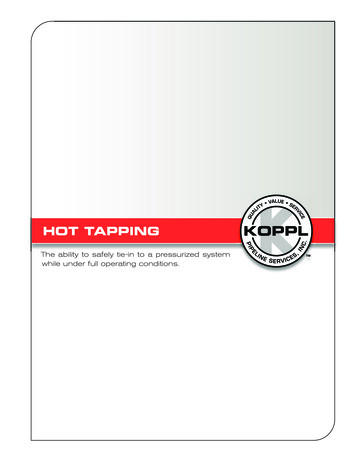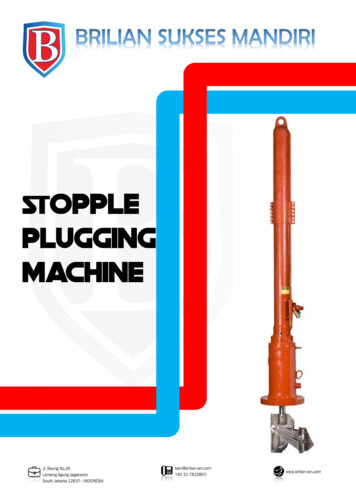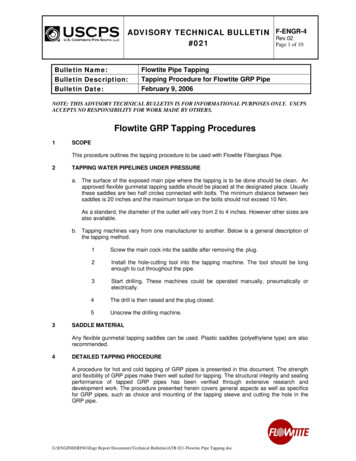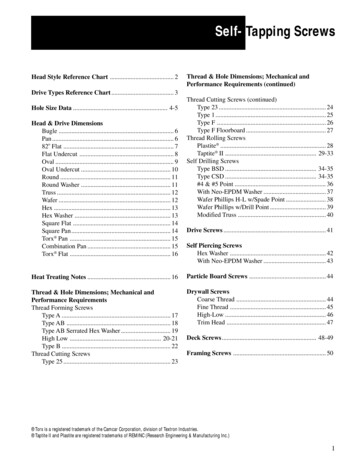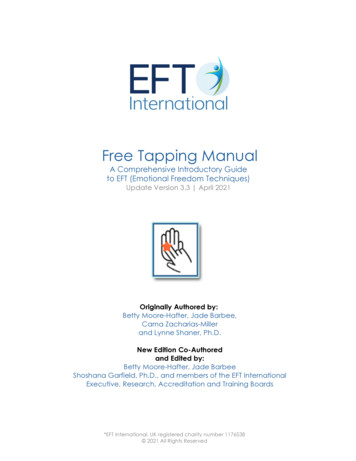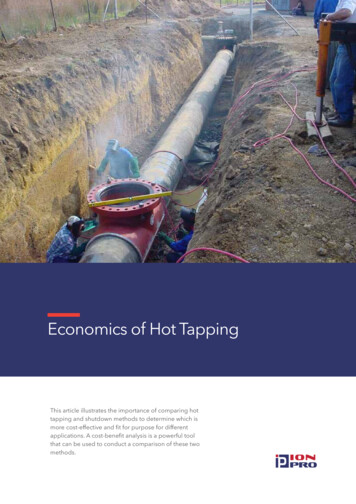
Transcription
Economics of Hot TappingThis article illustrates the importance of comparing hottapping and shutdown methods to determine which ismore cost-effective and fit for purpose for differentapplications. A cost-benefit analysis is a powerful toolthat can be used to conduct a comparison of these twomethods.
TABLE OF ine Maintenance, Upgrade and repair optionsConsiderations in choosing between shutdown and hot tappingThe EconomicsProject CostingHot Tapping CostsCost Benefit Analysis223334522.12.1.12.1.22.2Line Repair Case StudyBackgroundHot Tapping CostComplete Shutdown CostCost Benefit Analysis667783Conclusion94References101 ION Pro Services 2020
1. INTRODUCTION1.1PIPELINE MAINTENANCE, UPGRADE AND REPAIR OPTIONSMaintenance, emergency repairs, and upgrades form a significant part of any pipeline and plantoperations. These include, inter alia [1]: Attaching a branch connection to the lineInstalling an internal probe or monitorTo stop or redirect flow in a line for maintenance or repair purposesPositioning a branch fitting on an operating pressurized line, flowing or stagnantRemoving defects, i.e., dents or pipeline damageThere are two main methods to conduct these routine and emergency procedures on pipelines; theyare hot tapping and shutdowns. And each has its costs, benefits, and risks involved, requiring thoughtand investigation on the part of the owner to choose the most appropriate.These two methods are briefly described as:ShutdownA shutdown halts production in the pipelines temporarily to enable the safe execution of the work on apipeline without it being live. While a shutdown allows the safe access needed to perform the neededmaintenance and repairs, it has obvious cost implications with the loss of production throughput.Some of these associated costs with a shutdown are:1.Loss of revenue (while the system is shutdown)2.Maintaining compliance with national, state, and local regulations when shutting the systemdown is costly.3.Potential costs of litigation and associated political ramifications are also a common concernand reality with system shutdowns.Hot Tapping & Line StoppingHot tapping, also known as line tapping, pressure tapping, pressure cutting, or side cutting [2], and linestopping method enables expansion and modification of pipe networks to be done under pressurewithout any interruption or stopping the network. Hot tapping is a common practice when specific partsof a pipeline network have been damaged or require modifications. Line stopping isolates certain partsof the pipeline network, which can support hot tapping services.Hot tapping is a specialized procedure. Several factors need to be evaluated to determine if it is afeasible option before it can be considered a potential solution, including the condition of the pipeline,operation pressure, and pipe material. It is also essential to consider nearby emergency valves that canisolate the line, the working space around the connection, the location of other weld imperfections, andthe tap diameter.2 ION Pro Services 2020
1.2CONSIDERATIONS IN CHOOSING BETWEEN SHUTDOWN AND HOT TAPPINGThere are various factors for stakeholders to consider when choosing to use hot tapping/line stopping orto perform a full shutdown. They include, among other things: Economic Environmental Access to skilled staff (how readily available are hot tapping skills to the client) Duration available for repairs Local by-laws Service Level Agreements Etc.This article only deals with the economic portion of such a decision.Because it is specialized, hot tapping can be expensive. It does, however, hold significant benefits, suchas uninterrupted production and reduced emissions. It further reduces product losses, which can saveadditional costs for the company. [3]The argument is often made that a standard shutdown procedure is less expensive and, therefore, morecost-effective than hot tapping. However, it is essential to look at the procedures holistically, not only thecosts but also the benefits and losses involved with each.A high-level comparison of the two methods is not sufficient. A more in-depth look at the economicsinvolved with each is required to enable a fair comparison.It is important to note that the economic drivers of such a choice are only a part of the decision-makingprocess, as all other factors need to be considered.1.3THE ECONOMICS1.3.1 PROJECT COSTINGTo evaluate different cost estimations for a specific project, the best method to use is a cost-benefitanalysis [5]. A cost-benefit analysis is a simple comparison of the estimated costs associated with aproject or approach against the possible benefits of the project or approach.When doing a cost estimation for a project, the costs can be divided into two main categories, direct andindirect costs. Direct costs are broadly classified as being directly associated with the cost of executingthe project. In contrast, indirect costs cannot be allocated to a specific project but are shared acrossmultiple projects, e.g., project management, quality control, etc. [4]For the purpose of this article and staying with a simple project economics example, there is noconsideration for indirect costs.3 ION Pro Services 2020
The direct costs can be broken down into the following subcategories ilitiesContingency CostsMore detail on techniques and methods of estimating costs on a project can be found here. Evaluationof hot tapping and shutdown procedures, use the above subcategories to calculate the cost of each.1.3.2 HOT TAPPING COST BREAKDOWNIn order to do a cost-benefit analysis, the direct cost estimation for hot tapping needs to be completed.This is done at the start of a project and may often be a high-level cost estimation – depending on howmuch information is available at this stage. It is valuable to utilize previously completed project costings(if available) or to consult a hot tapping specialist to ensure realistic values are used and ensure asufficient level of confidence is obtained in the evaluation.Table 1 provides the cost breakdown for a typical hot tapping procedure.TABLE 1: HOT TAPPING COST BREAKDOWNItemDescriptionCost SubcategoriesIncludedMaterialsRaw materials and consumables tocomplete the actual upgrade/repair work,such as a valve.MaterialMechanical works (hottapping, line stopping,welding, etc.)Hot tapping equipment and service toperform the work. All welding, includingthe bypass line to gain access to an areathat will be worked on.Material, LaborEquipment, ServiceSite Establishment andTransportation CostsInfrastructure and offices, excavations, etc.required to be able to work in the area.Facilities, Labor, ServicePipeline EvaluationsInspection and testing done on thepipeline before the repair can be done.Service, LaborEquipmentManagementProject managementrequired.meetingsService, LaborPre-Commissioning andTestingCold/Pre-commissioning and testing thatneedtobedonebeforehotcommissioning can be performed.Service, LaborCommissioningHot commissioning after work has beencompleted for final acceptance.Service, LaborPreliminary and GeneralAny ad-hoc costs involved in the project,upgrading schedules, fencing, additionalsecurity required at the site, etc.Service, Facilities,Contingencyand4 ION Pro Services 2020The Mechanical works itemincludes the labor, material,and services involved in hottapping. In some cases, itmay be listed separately. Forsimplification in this article,it has been groupedtogether.
1.3.3 COST BENEFIT ANALYSISIt is important to note that some costs are applicable to both hot tapping and shutdown philosophies.And so, the cost-benefit analysis can be simplified by excluding these costs. They typically are: MaterialsSite Establishment and Transportation CostsManagementPreliminary and GeneralThe Pre-Commissioning and Testing task could have higher costs associated with hot tappingoperations than for shutdown due to additional testing required for the hot tapping equipment, if notperformed at the service provider's cost. Similarly, additional costs can be incurred for pipelineevaluations, as hot tapping is highly dependent on the integrity of the pipeline. This is not only for thehot tapping location but also for the up and downstream sections of the pipe.For commissioning, the hot tap operation could have a lower associated cost as a smaller section of thepipeline needs to be recommissioned. During a shutdown procedure, a large section of the pipelinemay need to be recommissioned after the repairs/work have been done, which could incur additionaltime leading to increased production losses.An additional cost that needs to be accounted for when conducting the cost-benefit analysis is a carbontax, which has only recently been implemented in countries across the world. In some locations thiscould have no impact, and in others it could be substantial cost item. This is mostly relevant for a gaspipeline where a shutdown procedure results in large emission quantities due to gas venting. In somecountries, this would result in additional tax penalties associated with the increase in emissions. The gasemissions during a hot tap are much lower than for a shutdown.A significant factor that also needs to be accounted for is the impact of the procedure on productionloss. This is only applicable to a shutdown where production is stopped during the process to allow therepair or upgrade to occur.Another consideration is product loss. The type of product determines cost significance. This is relevantfor both a shutdown and a hot tap since the section of the line under construction needs to be emptiedbefore work can be done. The amount of product emptied for a hot tap is significantly less than forshutdown. A liquid product can, in most cases, be recovered and reintroduced into the system. This is,typically, not possible for a gas which is vented to the atmosphere. In addition, for gas products,purging is required, which adds an additional cost to the procedure, more so for the shutdown than forhot tapping. [3]Two approaches can be used to account for the loss of production and product;a)b)the losses can either be included as additional costs for the shutdown procedure, orit can be listed as a benefit of the hot tapping procedure.It is, however, important that this cost/benefit is not accounted for twice.Even though this article attempts to discuss a general procedure, individual operators are advised toconsider company records and consult a hot tapping specialist when doing a cost-benefit analysis.Each pipeline and system are unique and may have additional factors that need to be accounted for.5 ION Pro Services 2020
2. LINE REPAIR CASE STUDYThe best way to illustrate how to conduct a cost-benefit analysis is by means of a simple example. Thecase study below describes a simplified and theoretical case in which either hot tapping or a shutdowncould have been employed to repair a defect in a liquid pipeline. Costs that would differ based on thetype of product (liquid vs. gas) are also highlighted.Note that no real-world case will ever be this simple. The purpose it to illustrate the philosophy at play indetermining the most suitable method for pipeline repair work.2.1BACKGROUNDCompany A is a gasoline supplier that operates a 30-mile gasoline pipeline between two cities. Duringroutine pipeline inspections, a defect was detected in the 8" pipeline that needs to be repaired toprevent a leak and contamination of the surrounding area. A 15 ft section of pipe needs to be replaced.The pipeline section was evaluated, and it was confirmed that only the 15 ft section needs to bereplaced and that the surrounding pipeline's condition and process parameters are suitable to enablehot tapping to be used for the repair.Company A is evaluating the most cost-effective method to repair the defect. They want to compare thecost of conducting the repairs through a shutdown or by making use of hot tapping/ line-stopping,which would typically be outsourced to an engineering or hot tapping contractor. The evaluation usedthe following process parameters and specifications:The items outlined in Section 1.2 are used to calculate the cost of repairing the pipeline. Typically, acompany would request a quote from a hot tapping specialist to perform the hot taps and line-stopping.In addition to the hot tapping and line stopping, the specialist will typically also procure and supply allthe required material required to perform the work unless the company prefers to procure the materialinternally.The following process was followed to conduct the cost analysis.1.Calculate the cost of hot tapping2.Calculate cost of complete shutdown3.Calculate production cost4.Calculate loss of product (if relevant)5.Compare costs and benefits between hot tapping and shutdown.The following assumptions were made:No product loss as the liquid product is recovered for both hot tapping and shutdown.Costs similar for hot tapping and shutdown which were excluded: Materials Site Establishment and Transportation Costs Management Preliminary and General6 ION Pro Services 2020
2.1.1 HOT TAPPING COSTDepending on the contractual agreement, either Company A or the hot tap specialist will develop abill of quantities (BOQ) to determine the cost of materials required. The specialist will also be able toprovide a line item in the quotation indicating the cost of the hot tapping and line stopping works.The costs that were identified to be similar for both hot tapping and shutdown are not included inthe cost analysis. The calculated costs are given in Table 1.The mechanical works are the highest contributing item (92% of the total) to the cost of hot tapping,mainly due to the equipment and the labor costs.TABLE 1: SUMMARY OF HOT TAPPING COSTSItemDescriptionFinal CostAMechanical works (hot tapping and line stopping) Contribution (%)483 27792BPipeline Evaluation
of hot tapping and shutdown procedures, use the above subcategories to calculate the cost of each. 1.3.2 HOT TAPPING COST BREAKDOWN In order to do a cost-benefit analysis, the direct cost estimation for hot tapping needs to be completed. This is done at the start of a project and may often be a high-level cost estimation – depending on how much information is available at this stage. It is .
